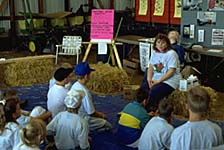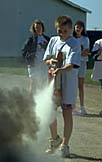A fun and effective way to teach farm kids about safety and health
Farms are great places for children to play and work. But they can also be places where kids are injured or even killed.
Research shows that children are much more likely than adults to be injured working on the farm. In Minnesota alone, over 80 children were killed in farming accidents in the past ten years. That's eight kids a year, or nearly one child a month!
How can farm kids learn to stay safe and healthy? One way is through a safety day camp, a program that teaches 8- to 13-year-olds the basics of farm safety and health.
If you're concerned about the safety of farm kids in your community, this pamphlet will outline how you can organize and run a safety day camp. You'll learn:

Nearly 300 American children are killed in farming accidents each year. Thousands more are injured and maimed. Why are these childhood injuries so common?
One reason is that children on the farm are often expected to do work that they're not mature enough to handle. A 10-year-old may look big and strong enough to run machinery or handle a large animal. But if the tractor tips, or the steer acts up, the child won't have the experience or the skill to stay safe. We'd never expect a 10-year-old to drive a car safely, yet many pre-teens drive the family combine, just because they're big enough to reach the clutch and brake pedals.
A kid who looks big is still a kid, and deserves all the protection that loving adults can provide. One big part of that protection is keeping kids from doing jobs they're simply not mature enough to handle.
Can All Farm Jobs Be Made Kid-Safe?The simple answer is no. Safety and child development experts strongly recommend that children be at least 12 or 13 before they begin to learn how to operate machines. Federal and state laws back this up by making it illegal to hire children under 16 to operate tractors or to perform other hazardous jobs off the family farm. This age requirement may be higher in some states.
But children can be taught to recognize and avoid hazards common to most farmsteads. Through safety day camps, kids can learn good safety habits that will stick with them once they're old enough to operate machines and drive the tractor.

At a safety day camp, a child learns about common farm hazards, and how to avoid them. Safety day camps are just like other summer camps, except that kids learn about things like electrical safety or basic first aid, instead of basket-weaving or outdoor cooking. Like other camps, the emphasis is on hands-on, interactive learning that is fun for the child (and for the instructor!)
The safety day camp format works best for 8- to 13 year-olds, who are generally eager to learn new ideas if they are presented in a challenging and entertaining way. (In many states, older youth may be eligible for "Hazardous Occupation" training, which certifies teens 14 and older to operate tractors and machinery. Contact your local vocational agriculture instructor or county extension agent for more information about this training.)

Organizing and running a farm safety day camp in your community is a big job, but it can be accomplished if it's broken down into steps. Allow at least three months to schedule and plan the day camp.
Form a planning committeeMost successful programs begin with a planning group or committee. Don't try to organize a safety day camp alone; there are other people in your community who can help you. Your first step is to invite them to an initial planning meeting. When considering who to include, don't forget someone from your local:
|
|
When should your safety day camp be held? If it is scheduled during periods of heavy farm work, you may lose kids whose parents are too busy to drive them into town. Consider weather-related conditions when scheduling the camp as well.
How should camp be set up? Many safety day camps consist of several "work stations," which use demonstrations, displays, role-playing and other concrete teaching methods and materials. These techniques keep kids interested and engaged far longer than a series of lectures or slide shows. For best results, each station's activities should last between 15 and 45 minutes, and involve no more than 15 kids at a time.
Work stations must have a clear purpose, or learning objective. Learning objectives describe specific actions that students should be capable of performing once they've visited a station. For example, after visiting a work station on proper fire extinguisher use, kids should be able to demonstrate how to use a dry chemical fire extinguisher on a small liquid fuel fire. By deciding in advance on a learning objective for each work station you set up, you'll make sure kids are learning practical, useful information.

The chart below shows a list of sample work stations with appropriate learning objectives and ideas for demonstrations. You may want to design others to suit your community's needs. Be sure, too, to schedule plenty of free time for kids to relax and play between work stations.
There are literally hundreds of possibilities for interesting and educational work stations. Before you design a new station, however, ask yourself:
This last question is especially important. Having children operate equipment, even under careful supervision, may send them a message that it's okay for them to run the tractor at home. Make sure you're not teaching children one thing, and showing them another.
| Work Station Subject | Learning Objective | Teaching Method |
| grain entrapment/suffocation | explain the dangers of flowing grain in gravity flow wagons and grain bins | demonstration with model grain container and action figure |
| all terrain vehicle safety | demonstrate use of appropriate protective clothing and proper ATV fit | practice trying on helmets, gloves and goggles; measure riders for fit on actual ATVs |
| power takeoff entanglement | describe dangers of unguarded pto shafts and recommend proper shielding | demonstration with dummy and uncovered pto |
| farm hazards | identify
10 common hazards on the farm |
scavenger hunt on real farm or model |
| electrical safety | describe 5 situations on the farm which could lead to electrocution or shock | demonstration with model (check with local electrical co-op) |
| emergency response/911 | demonstrate dialing 911 or emergency number, and giving directions to accident site | role playing with actual or mock emergency dispatch service |
| basic first aid | deliver first
aid to control bleeding and apply bandages |
practice bandaging different types of wounds |
| chemical protective gear | recommend appropriate protective clothing for adults using pesticides | hand out pesticide labels and choose correct protective gear |
| tractor overturn | list common tractor rollover factors, including speed and slope | demonstration with radio-controlled toy tractor on ramp |
A day camp can use up a tremendous amount of time, money and energy. You'll do best if your planning group breaks up into subcommittees. Have one group handle fund-raising, another scout locations, a third plan the content, and a fourth arrange for speakers and demonstrators. You'll also want people to publicize the day camp, handle registration and help with set-up and clean-up. Finally, you'll need someone to look back on the camp's activities and evaluate them. Make sure someone is specifically responsible for each of the tasks you identify. Set a deadline for the completion of each task. Most important, recognize and reward each volunteer's efforts.
Evaluate your effortsThe purpose of a farm safety day camp is to instill notions of health and safety in farm kids and to change their safety habits. How will you know if your camp has succeeded in its mission?
At this point, there is no research information that clearly says day camps work. We do know, however, that similar training efforts, such as youth training for ATV safety, have made teens better at identifying hazards and recognizing how to avoid them. If you spend the time to evaluate your day camp, you'll discover ways to improve your efforts next year, and you'll be adding to our understanding of how kids learn safety habits.
How can your safety day camp be evaluated? One good way is to give kids a survey to fill out while their parents are registering them and signing consent forms. In the survey, ask kids whether or not they actually do the things you'll be trying to teach them. Make the survey anonymous, so kids won't feel pressured to give you the "right" answer. A few weeks after day camp, call participants back and ask them if they've had a chance to demonstrate any of the things they've learned.
For More InformationThere are lots of people and organizations to turn to for help in organizing a safety day camp. Among them:
John Shutske
Extension Safety Specialist
University of Minnesota
St. Paul, Minnesota 55108
(612) 624-7444
Marilyn Adams
Farm Safety 4 Just Kids
P.O. Box 458
Earlham, Iowa 50072
(515) 758-2827
Information
on the World Wide Web: Farm Safety & Health Information Clearinghouse
at http://safety.cfans.umn.edu/
Copyright © 1997 Regents of the University of Minnesota. All rights reserved.
Produced by the Educational Development System, University
of Minnesota Extension Service.
In accordance with the Americans with Disabilities Act, this material is available in alternative formats upon request. Please contact your Minnesota county extension office or, outside of Minnesota, contact the Distribution Center at (612) 625-8173.
The University of Minnesota Extension Service is committed to the policy that all persons shall have equal access to its programs, facilities, and employment without regard to race, color, creed, religion, national origin, sex, age, marital status, disability, public assistance status, veteran status, or sexual orientation. University of Minnesota Extension Service Home Page
Disclaimer and Reproduction Information: Information in NASD does not represent NIOSH policy. Information included in NASD appears by permission of the author and/or copyright holder. More